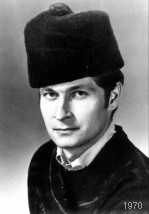|
Dennis Boxell
|
|
CLICK AN IMAGE FOR LARGER VIEW
Dennis C. Boxell was born in 1940 and grew up in Minneapolis, Minnesota. He was first introduced to the music and dance of the South Slavs at the age of fifteen. He learned the dances of the Croatian and Serbian immigrants with the encouragement of Lillian Kurkowsky of the St. Paul International Institute. While in Minneapolis, Dennis met Dick Crum, noted Balkan folklore researcher, who was then the choreographer of the Duquesne University Tamburitzans, and who inspired Dennis to begin to develop a professional interest in Balkan dance. His first love was Balkan dance, and after being exposed to it, he lived in Yugoslav communities in and around St. Paul, Minnesota, absorbing their songs and dances and learning about their foods and folklore.
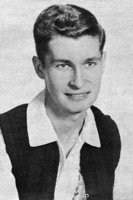
In 1960 and 1961, he was in Europe acting as an interperter of the Czech language for the United States Army Security Agency. In 1960, while on 30-day leave in West Germany, he traveled with the National Ensemble of Jugoslavia Kolo iz Beograda. The group director, Desa Djordjević, gave him a private tutor who worked with him every day on the dances he wanted to learn and bring back to the United States. This provided an excellent way of observing the dances and learning the correct styling of Yugoslav dances.
In London, he understudied with a Bulgarian dance group and added a wealth of original Bulgarian material. There, he studied Phillip Thornton's Yugoslav Dance Club and Danny Lumbley's Bulgarian Dance Group. In London he learned his "original five dances" that were to launch him on his teaching career. Those dances, familiar to folk dancers in the United States are Bavno Oro, Belo Lence (Vranjanka, aka Iz Banju Ide), Ravno Oro, Sitno Žensko, and Tresenica. Dennis lived in the world of dance, music, and folklore ever since.
In 1961, Dennis formed a performing group in South St. Paul, Minnesota. The members of the group were the children of Slavic immigrants, mostly Serbians. He finished his freshman year at the University of Minnesota and traveled West to study Slavic languages at the University of California in Berkeley (UCB). Enroute to California, at the annual folk dance festival in the small town of Richland, Washington, Dennis was "discovered" by John Filcich, creater of the San Francisco (California) Kolo Festival and owner of the largest Balkan folk dance record and music store in the United States. John brought Dennis to the Kolo Festival in November, 1962, where, to great acclaim, Dennis presented his "original five dances."
His success at the Kolo Festival brought him to the attention of the Stockton Folk Dance Camp, where he taught each of the next five years. His popularity led him to be the first Balkan dance teacher to teach an extended national tour, on which he taught not only his "original five dances," but also Šopsko Horo. Dennis taught at many other camps, including Holiday Camp in Southern California.
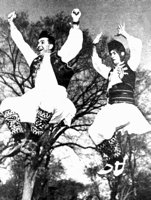 In 1963, Dennis traveled to the Balkans for more exposure to the arts and culture which had fascinated him for so many years. He visited and studied with eminent folklorists such as such as Kiril Dženev and Raina Katsarova of Bulgaria; Ivan lvanćan of Croatia; Nana Stefanaki of Lykeion Athens in Greece; Pece Atanasovski and Vasil Hadjimanov of Macedonia; and Milica Illijin and Dobrivoje Putnik of Serbia, who made it possible for him to travel to remote regions, collecting and recording more than 150 dances and their accompanying music he was later to introduce to the folkdance world. He also picked up a working knowledge of the Serbo-Croatian and Bulgarian languages.
In 1963, Dennis traveled to the Balkans for more exposure to the arts and culture which had fascinated him for so many years. He visited and studied with eminent folklorists such as such as Kiril Dženev and Raina Katsarova of Bulgaria; Ivan lvanćan of Croatia; Nana Stefanaki of Lykeion Athens in Greece; Pece Atanasovski and Vasil Hadjimanov of Macedonia; and Milica Illijin and Dobrivoje Putnik of Serbia, who made it possible for him to travel to remote regions, collecting and recording more than 150 dances and their accompanying music he was later to introduce to the folkdance world. He also picked up a working knowledge of the Serbo-Croatian and Bulgarian languages.
After 1963, Dennis made many trips to remote areas of the Balkans, including the villages of Zvan, Gorno Orizari, Dračevo, the plateau of Mariovo, and the Resen area in Yugoslav Macedonka; the villages of Petrovo, Opan, Gorno Oriahovo in Thrace; Dragoevo, Gigen in North Bulgaria; Luzani, Dalj, Njemči, Gundinči in Slavonia; Pinosavka, Mrčajevči, Neresnica, and Vukovica in Serbia; in Greece, Agia Varvara on Crete, Promahi and Orma near Edessa, and the village of Bouf in the Florina area; and Naoussa, Meliki, Goumenissa, and Vamvakofyto in Greek Macedonia. In 1965, from these research trips, he produced seven LP albums and 42 single 45's, and since 1998, over 30 CD's and cassettes. Many of these recordings have become standards in schools, clubs, and colleges throughout the world.
Dennis founded and was artistic director of the acclaimed Koleda, perhaps the best traditional Balkan music and dance ensemble ever formed in this country and which numbers among its alumni Jonathon Frye, Alex Eppler, Don LaCourse, Mark Morris, Marcus Holt Moskoff, Yves Moreau, and Mary Sherheart. From 1985, his award-winning ensemble, Akrites, a Seattle-based group, won praise from critics and audiences alike for their stunning and exciting presentation of authentic Greek folk dance. His group, the Ionians, based in Anaheim, California, won the coveted "Sweepstakes Award" in competition against sixty other Greek performing groups from the West Coast.
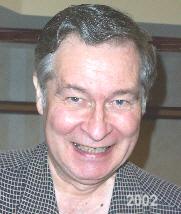 He was resident choreographer for the Vela Luka Ensemble of Anacortes, Washington, and guest choreographer for Radost and Ostali Muzikasi in Seattle, Washington, Brighan Young Dancers in Provo, Utah, Ethnic Dance Theater in Minneapolis, Minnesota, AMAN Folk Ensemble of Los Angeles, California, and Zrinski Frankopan (a Croatian group) of Chicago, Illinois. In 1972, he choreographed "Faust" for the Seattle Opera. He toured the United States and Canada many times, teaching Balkan dance at literally hundreds of colleges and community groups.
He was resident choreographer for the Vela Luka Ensemble of Anacortes, Washington, and guest choreographer for Radost and Ostali Muzikasi in Seattle, Washington, Brighan Young Dancers in Provo, Utah, Ethnic Dance Theater in Minneapolis, Minnesota, AMAN Folk Ensemble of Los Angeles, California, and Zrinski Frankopan (a Croatian group) of Chicago, Illinois. In 1972, he choreographed "Faust" for the Seattle Opera. He toured the United States and Canada many times, teaching Balkan dance at literally hundreds of colleges and community groups.
Acting as an impresario, he introduced to the nation such popular teachers as Atanas Kolarovski, Yves Moreau, Jaap Leegewater, and Slobodan Slović.
He was engaged as Dance Director for the Assumption Serbian Orthodox Church in Fair Oaks, California (near Sacramento). Every few months, he traveled to teach master classes in the Los Angeles, California, area, where he was choreographer / consultant for the Macedonian community in Whittier. In San Pedro, he directed the Yugoslav performing group, Pletenica. He also served as a research advisor for the Greek dance groups at the Annunciation Greek Orthodox Church in Sacramento, California.
In 1990, he released two new cassettes of village dance music, "Dances of Greek Macedonia" and "Dances of Greek Thrace" as a part of his efforts to rekindle enthusiasm for the basic village dances of the Balkan countries. In 2004 and 2005, he introduced a number of new Balkan Dance CD's and DVD's.
He remained active as a teacher at camps and seminars throughout the United States and Canada and was frequently asked to choreograph new works for other dance companies.
Dennis died from complications of pneumonia on Thursday, September 9, 2010.
Dances Dennis taught include
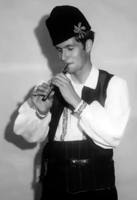 Ačano Mlada Nevesto,
Adana,
Ais Giorgis,
'Ajd Za Milim 'Ajd Za Dragim,
Ajde Lepa Maro,
Arap,
Baba Djurdja,
Bavna râČenica,
Bavno oro,
Bela Olymbia,
Belo lence,
Beogradsko Mangupsko,
Beranče (Berače),
Berovka,
Bilati,
Bjaganica,
Bogdanos,
Bučimiš,
Bufčansko,
Čarlama,
Čekurjankino horo,
Čerkeska,
Čestoto,
Čerkeska,
Četvorno horo,
Čifte Čamče,
Cigančica,
Ćiro,
Čučuk,
Ćuperlika,
Dajčovo horo,
Davoljike dajke,
Devojče devojče,
Didimotihos Syrtos,
Divotinsko horo,
Djurdjevica,
Dorčolka,
Dračevka,
Drhtavac,
Drmeš iz Posavina,
Dučec,
Dunavka,
Đangurica (Skudrinka),
Ekizliisko horo,
Elenino horo,
Fysouni,
Gaida,
Gaida Flambouras,
Gaida Kastorias,
Gaitanaki Rodou,
Gajda,
Gilanka,
Graovsko,
Gružanka,
Hvojcata,
Izfŭrli Kondak,
Iz Banu Ide - Vranjanka,
Jabučica,
Jadili (Jeddili or Jeitili),
Jagneto,
Jeni Jol,
Jove malaj mome,
Jovica,
Junak Gjorgi,
Kad Zaigra Pusta Slavonija,
Kalajdžisko I,
Kalajdžisko II,
Kalendara,
Kamenopolsko,
Kastorianos,
Katuše mome,
Keleruj,
Kermensko horo,
Koftos,
Kofto Sta Tria,
Kolenike,
Kolo,
Kopanica,
Kostensko pajduško,
Koutri,
Kraj Dunavsko,
Kritiko Syrto (Haniotiko),
Kriva kruška,
Kucano,
Lakhana,
Lesno (Issos Makedonikos),
Lesnoto,
Lile Lile,
Ljubino kolo,
Lovo horo,
Makedonikos horos,
Makedonsko bavno oro,
Mamo Oženi Me,
Marko skače,
Menousis,
Natalijino (Natalija),
Ne odi džemo,
Nebesko kolo,
Obluk,
Ogreala MeseČina,
Omal,
Omoljanca,
Ovčepolsko oro,
Pagaruša,
Pajduška,
Pajduška ("Mama na Enjo Dumaše"),
Palamakia,
Patrunino,
Pentozali,
Pinosavka<,
Pleskavac,
Po zelenoj trati,
Pop Marinko,
Postupano,
Potam Povam,
Potrčano,
Pousteno (Levendikos),
Povrateno,
Pravo Trakijsko,
Presjekača,
Pušteno (Leventikos),
Ranče,
Ratevka,
Ravno Oro,
Rukavica,
Sadilo Mome,
Sarajevka,
Sarakina pajduška,
Savila se Bela Loza,
Serghiani,
Sedi donka,
Șetnja,
Sfarlis,
Sheikhani,
Sitno Šopsko (Slow part and Fast part),
Sitno žensko Horo,
Skopska Crnogorka,
Skudrinka (Džangurica),
Slavjanka,
Slavonsko Kolo,
Šokačko,
Šopska râčenica - Obluk,
Šopsko horo,
Šopsko na lesa,
Šopsko pravo horo,
Sousta Rodou,
Sremski Orijent,
Stankino (Lipohoritikos),
Stara Vlajna,
Staro iikveško,
Svištovsko pravo horo,
Syrtos Haniatikos (Kritikos Syrtos),
Toska,
Tresenica,
Trite pâti (Tris Fores),
Tropanka,
Tropanka from Dobrudja,
Tropnalo oro,
U Kruševo ogin gori,
U selo tapan čukaše,
">U Šest koraka,
Vlakha,
Zaječarka,
Žakli,
Zavrzlama,
Žensko krsteno,
Žita,
Zonaridhikos,
and
Žvansko oro.
Ačano Mlada Nevesto,
Adana,
Ais Giorgis,
'Ajd Za Milim 'Ajd Za Dragim,
Ajde Lepa Maro,
Arap,
Baba Djurdja,
Bavna râČenica,
Bavno oro,
Bela Olymbia,
Belo lence,
Beogradsko Mangupsko,
Beranče (Berače),
Berovka,
Bilati,
Bjaganica,
Bogdanos,
Bučimiš,
Bufčansko,
Čarlama,
Čekurjankino horo,
Čerkeska,
Čestoto,
Čerkeska,
Četvorno horo,
Čifte Čamče,
Cigančica,
Ćiro,
Čučuk,
Ćuperlika,
Dajčovo horo,
Davoljike dajke,
Devojče devojče,
Didimotihos Syrtos,
Divotinsko horo,
Djurdjevica,
Dorčolka,
Dračevka,
Drhtavac,
Drmeš iz Posavina,
Dučec,
Dunavka,
Đangurica (Skudrinka),
Ekizliisko horo,
Elenino horo,
Fysouni,
Gaida,
Gaida Flambouras,
Gaida Kastorias,
Gaitanaki Rodou,
Gajda,
Gilanka,
Graovsko,
Gružanka,
Hvojcata,
Izfŭrli Kondak,
Iz Banu Ide - Vranjanka,
Jabučica,
Jadili (Jeddili or Jeitili),
Jagneto,
Jeni Jol,
Jove malaj mome,
Jovica,
Junak Gjorgi,
Kad Zaigra Pusta Slavonija,
Kalajdžisko I,
Kalajdžisko II,
Kalendara,
Kamenopolsko,
Kastorianos,
Katuše mome,
Keleruj,
Kermensko horo,
Koftos,
Kofto Sta Tria,
Kolenike,
Kolo,
Kopanica,
Kostensko pajduško,
Koutri,
Kraj Dunavsko,
Kritiko Syrto (Haniotiko),
Kriva kruška,
Kucano,
Lakhana,
Lesno (Issos Makedonikos),
Lesnoto,
Lile Lile,
Ljubino kolo,
Lovo horo,
Makedonikos horos,
Makedonsko bavno oro,
Mamo Oženi Me,
Marko skače,
Menousis,
Natalijino (Natalija),
Ne odi džemo,
Nebesko kolo,
Obluk,
Ogreala MeseČina,
Omal,
Omoljanca,
Ovčepolsko oro,
Pagaruša,
Pajduška,
Pajduška ("Mama na Enjo Dumaše"),
Palamakia,
Patrunino,
Pentozali,
Pinosavka<,
Pleskavac,
Po zelenoj trati,
Pop Marinko,
Postupano,
Potam Povam,
Potrčano,
Pousteno (Levendikos),
Povrateno,
Pravo Trakijsko,
Presjekača,
Pušteno (Leventikos),
Ranče,
Ratevka,
Ravno Oro,
Rukavica,
Sadilo Mome,
Sarajevka,
Sarakina pajduška,
Savila se Bela Loza,
Serghiani,
Sedi donka,
Șetnja,
Sfarlis,
Sheikhani,
Sitno Šopsko (Slow part and Fast part),
Sitno žensko Horo,
Skopska Crnogorka,
Skudrinka (Džangurica),
Slavjanka,
Slavonsko Kolo,
Šokačko,
Šopska râčenica - Obluk,
Šopsko horo,
Šopsko na lesa,
Šopsko pravo horo,
Sousta Rodou,
Sremski Orijent,
Stankino (Lipohoritikos),
Stara Vlajna,
Staro iikveško,
Svištovsko pravo horo,
Syrtos Haniatikos (Kritikos Syrtos),
Toska,
Tresenica,
Trite pâti (Tris Fores),
Tropanka,
Tropanka from Dobrudja,
Tropnalo oro,
U Kruševo ogin gori,
U selo tapan čukaše,
">U Šest koraka,
Vlakha,
Zaječarka,
Žakli,
Zavrzlama,
Žensko krsteno,
Žita,
Zonaridhikos,
and
Žvansko oro.
